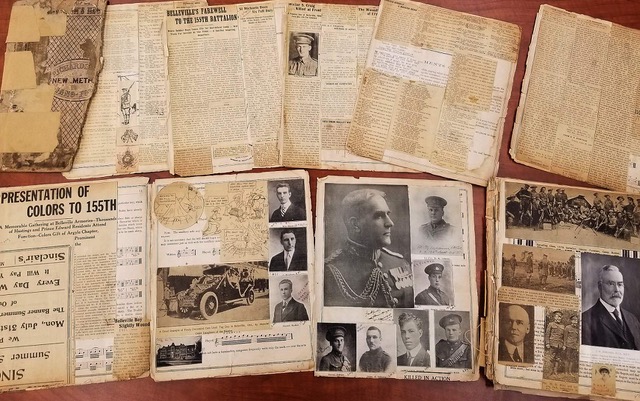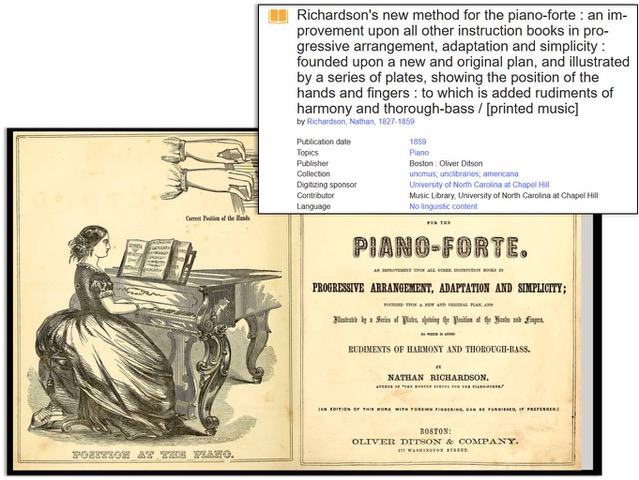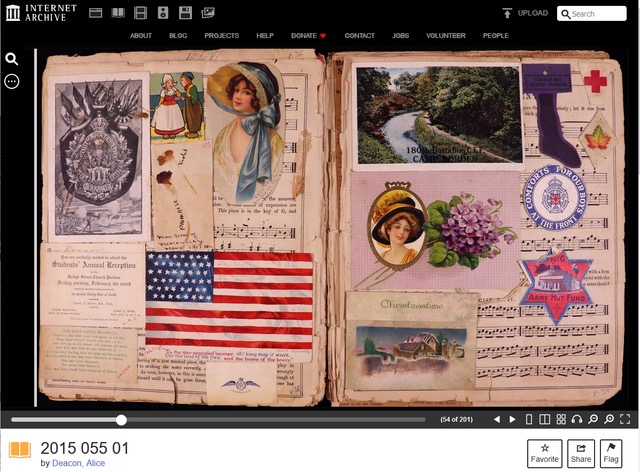Guest post by: Amanda Hill, Archivist of the Community Archives of Belleville and Hastings County, a member of the Community Webs program and a contributor to the Internet Archive.
One of the things archivists get excited about is the importance of ‘original order’. This is the idea that the arrangement of records by their creator has significance to our understanding of the records themselves. Wherever possible, archivists will try to determine the original order of materials in their care.
An item received at the Community Archives of Belleville and Hastings County in 2015 presented something of a puzzle in this respect. It was a scrapbook from the First World War, of newspaper clippings and other memorabilia which had been pasted into a printed book. The binding of the book had partially come apart and the early pages of the scrapbook had been jumbled into no particular order, with clippings dated 1917 mixed in with those from 1916.

Examination of the scrapbook revealed that its owner was Alice Deacon, born in Belleville, Ontario, on September 27th, 1899. She was the child of Daniel Deacon and his wife, Catherine Dugan. During the First World War, the Deacons were living at 107 Station Street, Belleville. They were Roman Catholics and Alice was probably a student at St. Michael’s Academy on Church Street.
Alice had three older brothers: James, Frederick and Francis (Frank). Frank joined the Canadian Expeditionary Force on March 23rd, 1916 in Belleville and it may have been this event which triggered Alice’s interest in the war. Frank’s service record is available from Library and Archives Canada.
The scrapbook mainly comprises cuttings from The Daily Intelligencer newspaper during the war, where Alice carefully recorded references to Belleville boys overseas, sometimes annotating the clippings with her own observations about whether a man had returned from the front, or which school he had attended.
Alongside the newspaper extracts are other more personal items, such as postcards, theatre programs, calling cards, invitations and ticket stubs. This page illustrates some of the variety:

Here we find an invitation, two pressed flowers “from ruins of a French village, May 1917” and a picture “off a box of chocolates Jim gave me for my birthday, 1916.”
Alice did not begin with blank pages: she used a copy of Richardson’s New Method for the Piano-Forte, originally published in 1859 by Nathan Richardson. In between Alice’s pastings, we can see parts of the text of the underlying book. Some of the pages still had visible page numbers, although most did not, but the majority had at least some legible words and phrases. This was the key to re-creating Alice’s original order.
We discovered that the Richardson book had been digitized by the University of North Carolina at Chapel Hill and was available online through the Internet Archive.

This digital copy proved essential in discovering the original order of the scrapbook. Using the Internet Archive’s searching facility, we were able to locate the identifiable words and match them to the page numbers of the original book. Once all the pages were identified, it was a simple matter to put them back into the order they would have been in when the book was intact.
Alice’s brother Frank came home safely from the war and was demobilized on May 23rd, 1919. Alice worked as a stenographer and bookkeeper in Belleville until 1929, when she married Leo Houlihan in St. Michael’s Church. She then left Belleville to live with Leo in Lindsay, Ontario. She died in 1955 and was buried in the Our Lady of Mercy Roman Catholic cemetery in Sarnia, Ontario.
Her scrapbook arrived back in Belleville by mail, sixty years after Alice’s death. Thanks are due to the anonymous donor for sharing this glimpse into a young woman’s wartime life, and also to our colleagues at the University of North Carolina and the Internet Archive for making it possible to reconstruct the scrapbook as it was when Alice first created it.
We have mainly been sharing our newspaper collection at the Internet Archive, but once it was digitized, we felt compelled to share Alice’s scrapbook there, too!

Very nice, and touching. Happy her brother got back – many Canadians did not. Had an effect beyond their numbers, the historians tell us.
Thank you for the professional insight.
I wonder why the US flag is prominent. The US didn’t enter the war until 1918. Another pandemic year BTW.
Speaking of old books (weren’t we?) I strongly recommend All Quiet on the Western Front. You’ll have to keep reminding yourself it’s from the “other side”. Remarque was wounded four times, ‘healed’ and sent back three, I believe. Authentic.
Thank you for posting this.
I’m currently digitizing a scrapbook of photos and tintypes from my deceased parents. The contents are unlikely to be of significant historical value. Does the Archive offer a service where I can pay you to host the archived content? I haven’t seen any copyrighted material, and would be willing to put it in the Public Domain.
Wow what a wonderful collection of war time history. I’m sure a relative interested in the family history would love to have a copy of this scrapbook in their possession.
Keep up the good work guys and I hope more amazing finds like this are preserved for future generations to look over.
Although the author intends to address the principles of order in information archiving, the narrative is also very interesting.
thanks for archive.org
Great !
Great work, thank you for sharing
@Elizabeth Greene — You are welcome (and it would be appreciated) to upload the scrapbook yourself, thru https://archive.org/create ; whatever format your digitization is in is fine. Thanks for asking about it!